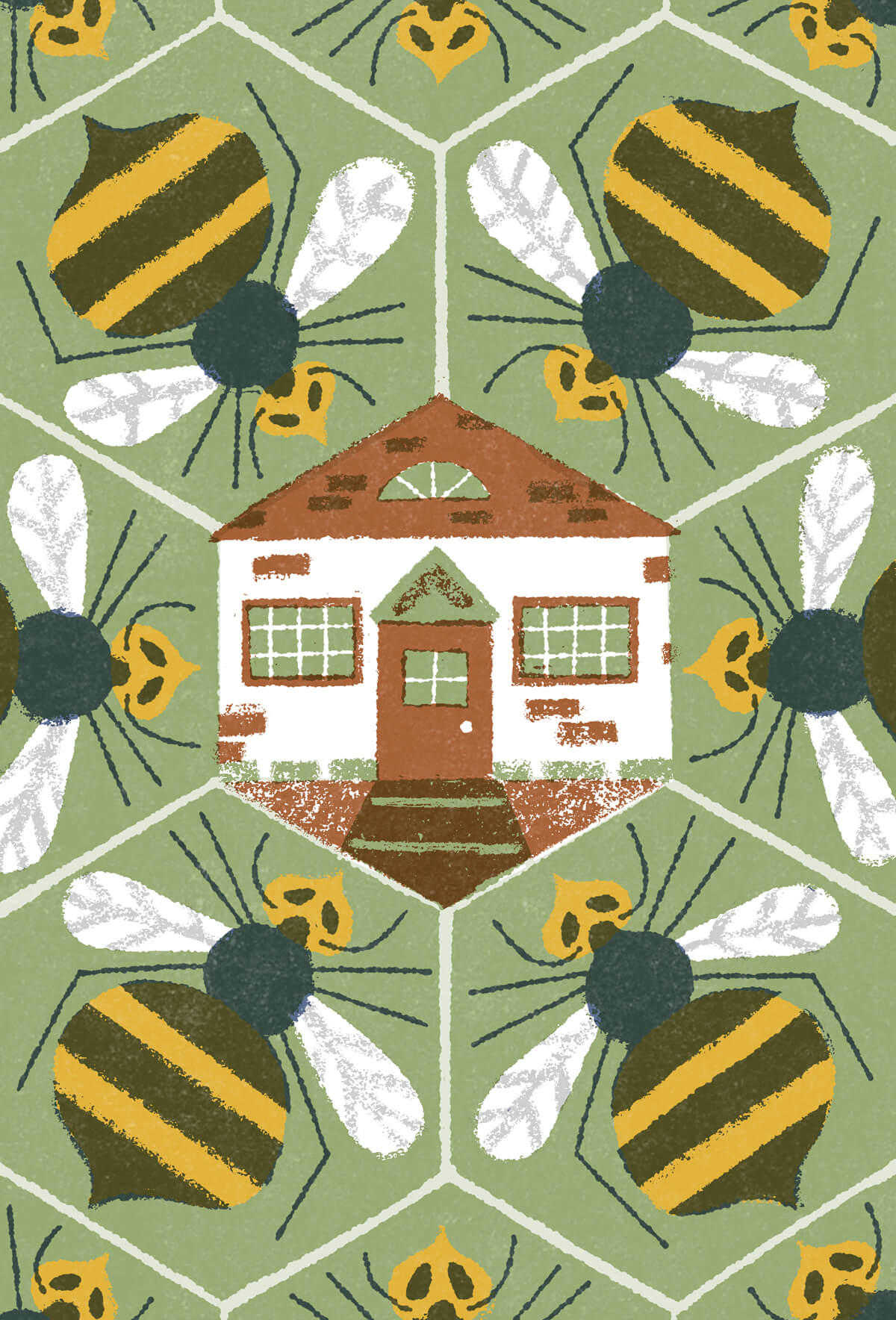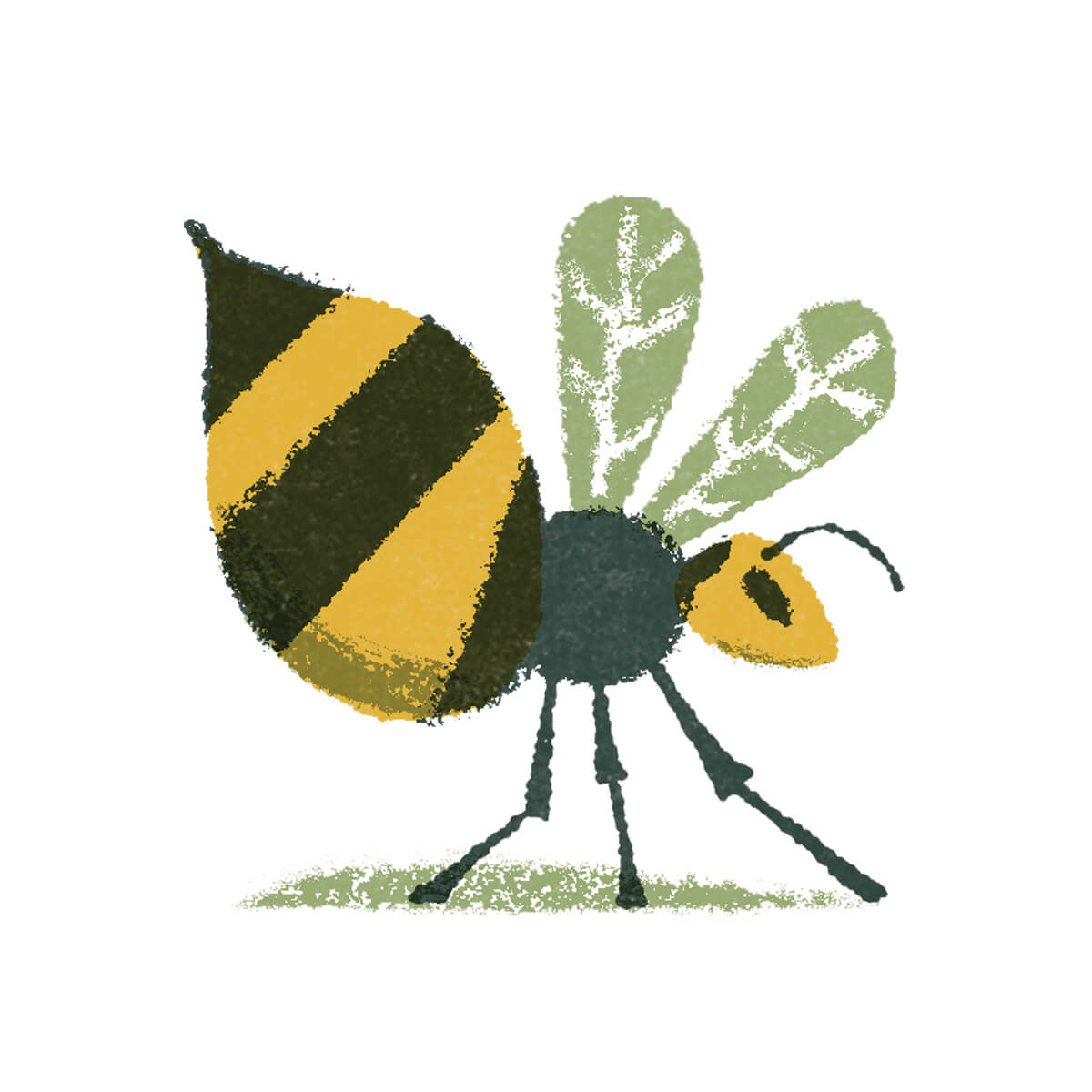Home & Living
Essay: What Do You Do When Wasps Take Up Residence in Your Bedroom?
When threatened, wasps swarm in large groups to defend their homes, even when their home is actually your home, and your name is on the mortgage.

“This is no way to begin the week,” said my husband, Mike, on a hot Monday morning this past summer, “but I think we have a leak.”
I sighed, walked over to the bay window in our bedroom, and peered up at the stain on the ceiling. “I’ll call a roofer,” I said.
But as I looked out the window and craned my neck toward the roofline, I noticed something even more alarming: that bees, lots of bees, or so I thought, were making, well, a beeline for what I later realized was a crack between the exterior stone and cedar siding on our home. The leak was not a leak, in fact, but the handiwork of the insects.
Mike poked the ceiling to determine the severity of the issue. His finger went through the mushy drywall. Unfazed, he went to the kitchen, unrolled a stretch of Saran Wrap, taped it across the spongy ceiling with duct tape around the perimeter—and then left for work.
I am war-weary when it comes to home ownership. After 36 years and four homes, I assumed I’d battled it all—from the lightning strike that toppled a tree on the front lawn of my Lutherville rancher and screwed up the entire electrical system to the septic backup in my 1940s fixer-upper.
Seven years ago, when we moved to our 1979 Pikesville townhome with its gleaming new parts—new plumbing and electrical systems, new roof and HVAC system—we thought home headaches were a thing of the past. And with the exception of the time a finch flew into the house and landed on the 30-foot beam along our living room ceiling, plus an occasional visit from the 7-foot black snake who surfaced for sun from the subfloor of our deck where it lived, and an ongoing battle with moths, we’ve mostly managed to live in our empty nest with ease. Alas, the insect-like hum we had noticed for days in our bedroom was not coming from the neighbors in the adjoining townhouse (they were on vacation), but inside our walls.
At this point, I invoked the famous Woody Allen line, “I’m at two with nature.”
Things that go buzz are a very specific kind of nuisance. (Search: “Bees or wasps in walls of house” on Google if you want to see what I mean. An image search is even more terrifying.) The first step in eradicating winged insects that buzz is to determine what kind you have. If they’re honeybees, which are protected pollinators, the entire hive must be moved intact, and no one will exterminate for them.
After a brief search, I found a team of two on the internet claiming to be exterminators. Hours later, they were standing outside my bedroom window. One of them mentioned that he was a former security guard at the National Gallery of Art, the other was wearing a crepe bee suit. Mostly what they had going for them was that they returned my call. They diagnosed the issue—these were not kindly honeybees but wasps, the meanest mother-effers in the insect world.
Unlike bees, they’re capable of stinging numerous times and are carnivores who first sting their prey and then eat it. (After watching a YouTube video, I learned that when feeding their young, they narcotize their prey, tranquilizing it and keeping it alive until the hatched larvae are ready to feed.) When threatened, wasps swarm in large groups to defend their homes, even when their home is actually your home, and your name is on the mortgage.

All I knew for sure is that our nest now belonged to the wasps.
So, a plan was made for these “experts” to exterminate the following week, then, as part of the remediation, repair my ceiling for the starting price of $2,500 (or more, depending on the size of the nest). As they sat on my bed and petted my dogs, suspicion was starting to set in, but my judgment was clouded by fear and prevented me from asking even the most obvious questions, like since when do exterminators also do home construction? And who removes a live wasp-filled hive? All I knew for sure is that our nest now belonged to the wasps.
Over the next few days, Mike donned latex gloves, a hoodie sealed with duct tape at the wrist, and sweatpants taped at the ankle. Each night he gingerly unwrapped the Saran, sprayed insecticide Rambo-style into the hole, and sealed it up again. The quarter-sized hole continued to enlarge, providing a viewing window—we were basically living inside the hive with that thin coating of Saran the only thing separating us from total disaster. When the wasps continued to come and go, and I had time to come to my senses, I knew it was time to get a second opinion.
A friend recommended Raven Termite & Pest Control—their motto, “If it’s crawling up your wall, who you gonna call?”—and told me to ask for Troy. Within days, Troy arrived, in khakis and a Raven Termite shirt looking the part of a real professional. Unlike the last duo, I was impressed by his plan to kill the wasps before evicting them and hired him on the spot. Oh, and his fee? $250.
First, Troy used a long rod with a pincer that sprayed a white dust in the exterior crack. The wasps, he explained, would then carry the poison into the hive. After the spraying, our ceiling became softer and spongier. At night, I stayed up wondering just how many stings it would take to kill us. (One random search said 1,000.) I was equal parts freaked out and fascinated.
Humans have coexisted with insects since the beginning of time, but we are far outnumbered. According to the Entomological Society of America, there are 10 quintillion insects (that’s 18 zeroes!) on Earth at any given time. There are more than 200 million insects for each person on the planet. There are also more than 100 million species of wasps worldwide—at least a thousand of which seemed to be in our bedroom.
Troy returned 10 days later, to give time for the poison to do its job. With each spraying, the paint continued to stretch and soften, until finally a tiny bit of the honeycomb hive was revealed. It was nestled inside a fan-shaped, brown, and bark-like, protective layer.
“This should do the trick,” Troy said.
Another week went by, and Troy returned yet again. It was time. Standing inside our bedroom, he peeled back the plastic, as hundreds of dead wasps, in various states of decay, fell into a bucket on the floor. At last, the entire nest was exposed. The honeycomb structure was textbook—intricate, handmade (well, actually built from wood fiber chewed into a paper-like pulp and vomited into our ceiling)—and undeniably beautiful.
The hive was covered in poisonous white dust, which gave it a delicate, lace-like quality. On some level, I admired these wasps and their worker bee-ness as purposeful predators whose life’s work is singular and simple: to burrow, usually deep down into the soil (or ceiling), then procreate and eat other insects, which helps keep pest populations down. With his gloved hands, Troy extracted the nest, layer by delicate layer—three in all.
As he excavated and sprayed, several larvae emerged from their sacks and started to hatch before our eyes. “New life,” he said.
When it was all over, in a place once teeming with life, there was now nothing but a hollow hole. I’ll admit, I felt a little melancholy. I got that same feeling years ago when a towering old tree was looming close to our house, and we were forced to cut it down. It never feels good to kill something that was once alive, whatever it is—and for whatever the reason.
Life teaches us lessons, even when we weren’t looking for one in some small cavity between the drywall and the roof of our house. In the end, life is defined by opposing forces—floating and falling, beauty and brutality, birth and death, struggle and survival.
And even the most fortified nest can’t ward off what sometimes slips through the cracks. All you can do is try.